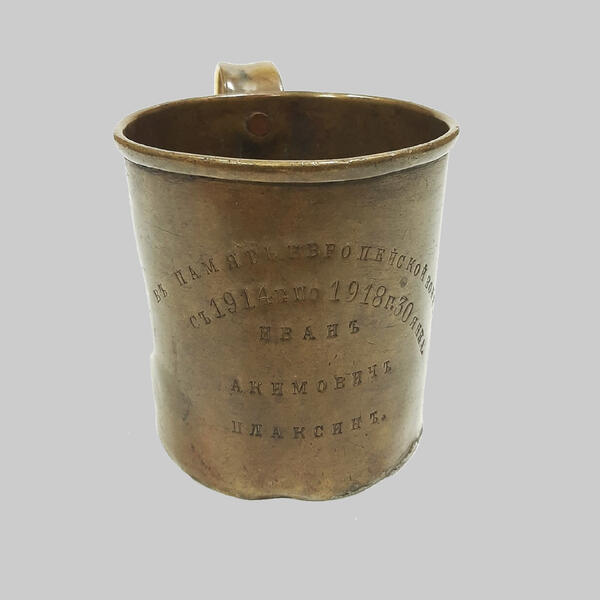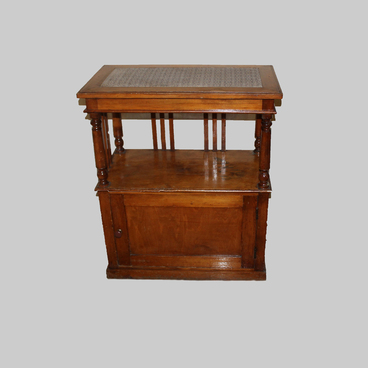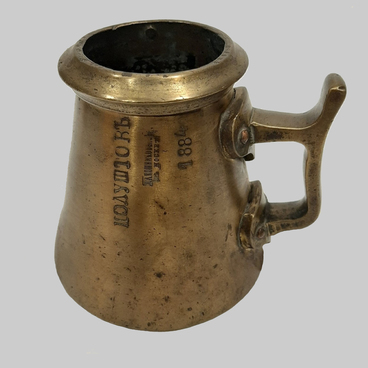Mug with the inscription ‘In memory of the 1914-1918 European War’ is still in good condition even after a century. We can consider two versions of the origin of this item. During World War I, Russian soldiers often turned shell casings into vessels that were decorated with a pattern or inscription. The inscription was made in field conditions, in the regimental forge, or in the rear hospital. Self-made mugs were often given by fellow soldiers to each other as a souvenir, and the presented mug could be such a gift. According to another version, this old army mug made of thick sheet copper was part of the standard equipment of the Tsarist Army of the early 20th century. During World War I, every soldier and junior officer of the Tsarist Army had such a mug and could not only drink from it, but also warm up food on a fire in it.
The mug has a very unusual inscription ‘In memory of the 1914-1918 European War. January 30. Ivan Akimovich Plaksin’. The name of the war, i.e. European War, also deserves attention. The retrospective name ‘World War I’ appeared in world historiography only in 1939. At the beginning of the war, it was called the ‘Great War’ or the First European War. In the patriotic propaganda of the Russian Empire, the names ‘Second Patriotic’ and ‘Great Patriotic’ appeared. Thus, the authorities appealed to the memory of the Patriotic War of 1812. In everyday life, the war was called ‘German’.
Now the topic of preserving the historical memory of Russia’s participation in World War I is widely in demand in the domestic scientific and cultural space. It stands out in a separate layer, including in the museum world. Even during World War I, certain intellectuals who participated in humanitarian work at the front and in the rear began collecting items and documents. Thanks to this, the Museum of the All-Russian Union of Cities and some other centers for collecting historical and cultural monuments of World War I, which were abolished after the revolution, were founded.
In the 1920s and 1930s, the theme of World War I and the history of the Russian army of the pre-revolutionary period in general virtually disappeared from the scope of museum work, since the storage of royal orders, military uniforms, and edged weapons created a real threat of arrest for their owners on suspicion of counter-revolutionary activities. In the 1950-1970s, this topic was covered selectively through the prism of the revolution and those participants who later took the side of the Soviet government. Social status also mattered when covering events. More was said about the rank and file than about the generals.
The mug has a very unusual inscription ‘In memory of the 1914-1918 European War. January 30. Ivan Akimovich Plaksin’. The name of the war, i.e. European War, also deserves attention. The retrospective name ‘World War I’ appeared in world historiography only in 1939. At the beginning of the war, it was called the ‘Great War’ or the First European War. In the patriotic propaganda of the Russian Empire, the names ‘Second Patriotic’ and ‘Great Patriotic’ appeared. Thus, the authorities appealed to the memory of the Patriotic War of 1812. In everyday life, the war was called ‘German’.
Now the topic of preserving the historical memory of Russia’s participation in World War I is widely in demand in the domestic scientific and cultural space. It stands out in a separate layer, including in the museum world. Even during World War I, certain intellectuals who participated in humanitarian work at the front and in the rear began collecting items and documents. Thanks to this, the Museum of the All-Russian Union of Cities and some other centers for collecting historical and cultural monuments of World War I, which were abolished after the revolution, were founded.
In the 1920s and 1930s, the theme of World War I and the history of the Russian army of the pre-revolutionary period in general virtually disappeared from the scope of museum work, since the storage of royal orders, military uniforms, and edged weapons created a real threat of arrest for their owners on suspicion of counter-revolutionary activities. In the 1950-1970s, this topic was covered selectively through the prism of the revolution and those participants who later took the side of the Soviet government. Social status also mattered when covering events. More was said about the rank and file than about the generals.



